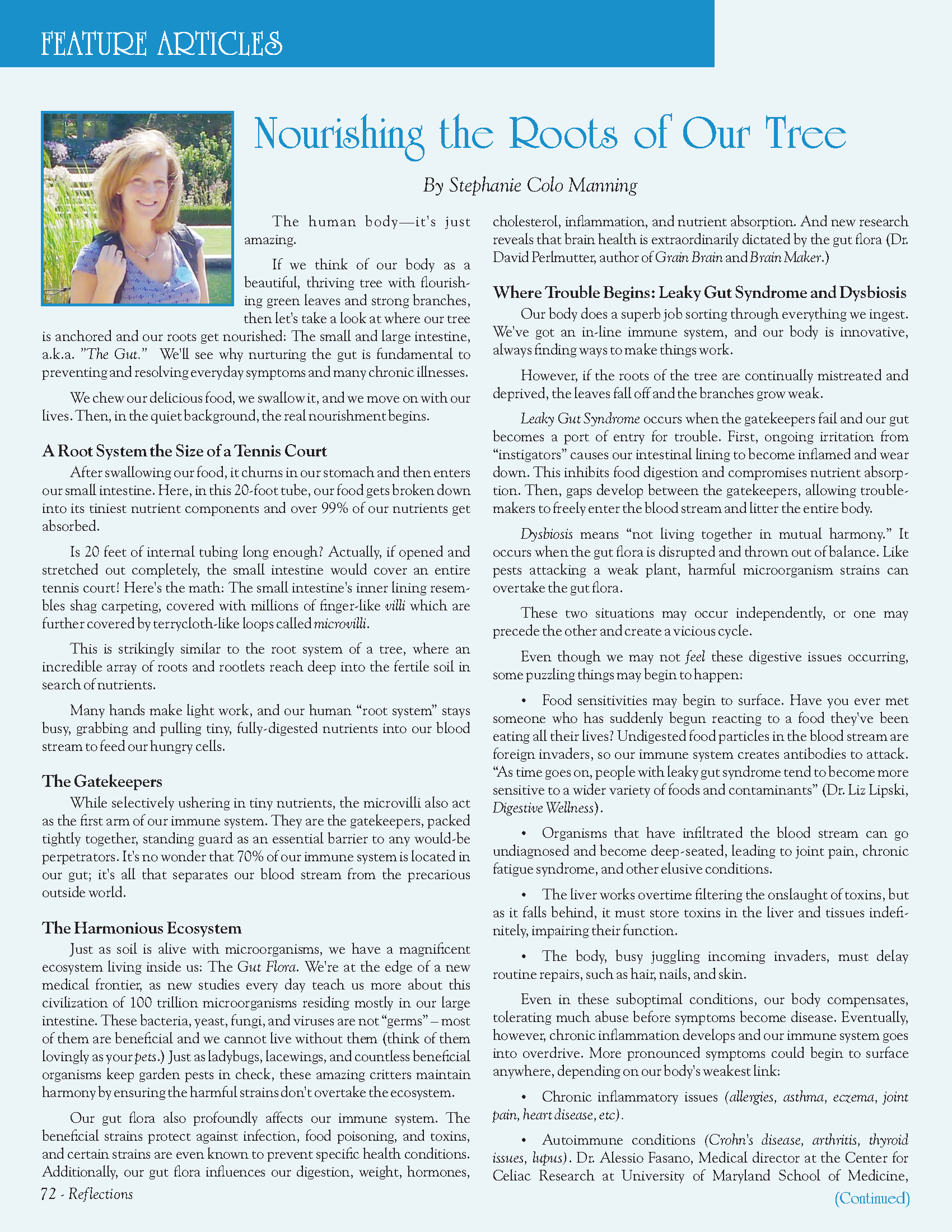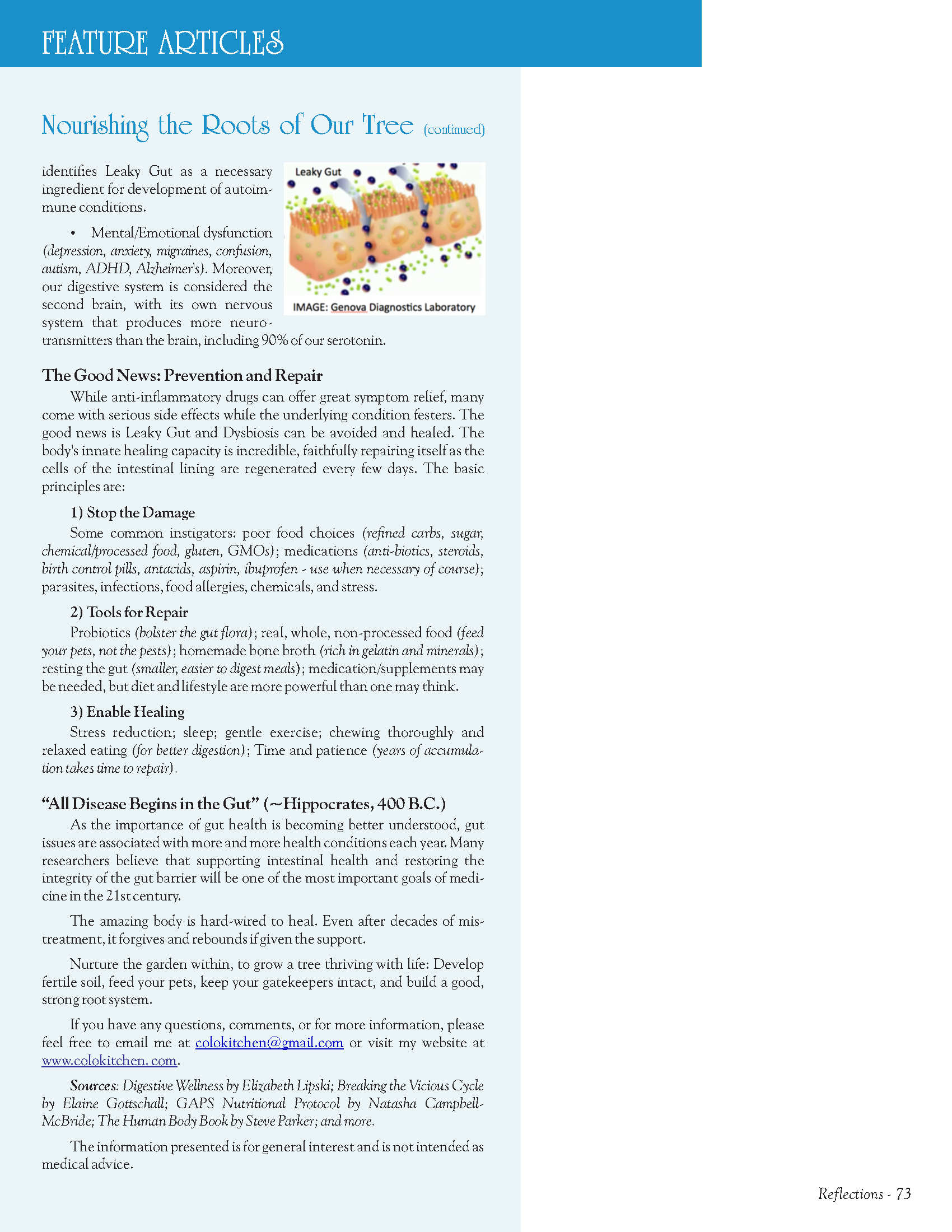By Stephanie Colo Manning
The human body. It’s just amazing
If we think of our body as a beautiful, thriving tree with flourishing green leaves and strong branches, then let’s take a look at where our tree is anchored and our roots get nourished: The small and large intestine, a.k.a. “The Gut.” We’ll see why nurturing the gut is fundamental to preventing and resolving everyday symptoms and many chronic illnesses.
We chew our delicious food, we swallow it, and we move on with our lives. Then, in the quiet background, the real nourishment begins.
A Root System the Size of a Tennis Court
After swallowing our food, it churns in our stomach and then enters our small intestine. Here, in this 20 foot tube, our food gets broken down into its tiniest nutrient components and over 99% of our nutrients get absorbed.
Is 20 feet of internal tubing long enough? Actually, if opened and stretched out completely, the small intestine would cover an entire tennis court! Here’s the math: The small intestine’s inner lining resembles shag carpeting, covered with millions of finger-like villi which are further covered by terrycloth-like loops called microvilli.
This is strikingly similar to the root system of a tree, where an incredible array of roots and rootlets reach deep into the fertile soil in search of nutrients.
Many hands make light work, and our human “root system” stays busy, grabbing and pulling tiny, fully-digested nutrients into our blood stream to feed our hungry cells.
The Gatekeepers
While selectively ushering in tiny nutrients, the microvilli also act as the first arm of our immune system. They are the gatekeepers, packed tightly together, standing guard as an essential barrier to any would-be perpetrators. It’s no wonder that 70% of our immune system is located in our gut; it’s all that separates our blood stream from the precarious outside world!
The Harmonious Ecosystem
Just as soil is alive with microorganisms, we have a magnificent ecosystem living inside us: The Gut Flora. We’re at the edge of a new medical frontier, as new studies every day teach us more about this civilization of 100 Trillion microorganisms residing mostly in our large intestine. These bacteria, yeast, fungi, and viruses are not “germs” – most of them are beneficial and we cannot live without them (think of them lovingly as your pets.) Just as ladybugs, lacewings, and countless beneficial organisms keep garden pests in check, these amazing critters maintain harmony by ensuring the harmful strains don’t overtake the ecosystem.
Our gut flora also profoundly affects our immune system. The beneficial strains protect against infection, food poisoning, and toxins, and certain strains are even known to prevent specific health conditions. Additionally, our gut flora influences our digestion, weight, hormones, cholesterol, inflammation, and nutrient absorption. And new research reveals that brain health is extraordinarily dictated by the gut flora (Dr. David Perlmutter, author of Grain Brain and Brain Maker.)
Where Trouble Begins: Leaky Gut Syndrome & Dysbiosis
Our body does a superb job sorting through everything we ingest. We’ve got an in-line immune system, and our body is innovative, always finding ways to make things work.
However, if the roots of the tree are continually mistreated and deprived, the leaves fall off and the branches grow weak.
Leaky Gut Syndrome occurs when the gatekeepers fail and our gut becomes a port of entry for trouble. First, ongoing irritation from “instigators” causes our intestinal lining to become inflamed and wear down. This inhibits food digestion and comprises nutrient absorption. Then, gaps develop between the gatekeepers, allowing trouble-makers to freely enter the blood stream and litter the entire body.
Dysbiosis means “not living together in mutual harmony.” It occurs when the gut flora is disrupted and thrown out of balance. Like pests attacking a weak plant, harmful microorganism strains can overtake the gut flora.
These two situations may occur independently, or one may precede the other and create a vicious cycle.
Even though we may not feel these digestive issues occuring, some puzzling things may begin to happen:
- Food sensitivities may begin to surface. Have you ever met someone who has suddenly begun reacting to a food they’ve been eating all their lives? Undigested food particles in the blood stream are foreign invaders, so our immune system creates antibodies to attack. “As time goes on, people with leaky gut syndrome tend to become more sensitive to a wider variety of foods and contaminants” (Dr. Liz Lipski, Digestive Wellness).
- Organisms that have infiltrated the blood stream can go undiagnosed and become deep-seated, leading to joint pain, chronic fatigue syndrome, and other elusive conditions.
- The liver works overtime filtering the onslaught of toxins, but as it falls behind, it must store toxins in the liver and tissues indefinitely, impairing their function.
- The body, busy juggling incoming invaders, must delay routine repairs, such as hair, nails, and skin.
Even in these sub-optimal conditions, our body compensates, tolerating much abuse before symptoms become disease. Eventually, however, chronic inflammation develops and our immune system goes into overdrive. More pronounced symptoms can begin to surface anywhere, depending on our body’s weakest link:
- Chronic inflammatory issues (allergies, asthma, eczema, joint pain, heart disease, etc.)
- Autoimmune conditions (Crohns, arthritis, thyroid issues, lupus.) Dr. Alessio Fasano, Medical director at the Center for Celiac Research at University of Maryland School of Medicine, identifies Leaky Gut as a necessary ingredient for development of autoimmune conditions.
- Mental/Emotional dysfunction (depression, anxiety, migraines, confusion, autism, ADHD, Alzheimer’s.) Moreover, our digestive system is considered the second brain, with its own nervous system that produces more neurotransmitters than the brain, including 90% of our serotonin!
The Good News: Prevention & Repair
While anti-inflammatory drugs can offer great symptom relief, many come with serious side effects while the underlying condition festers. The good news is Leaky Gut and Dysbiosis can be avoided and healed. The body’s innate healing capacity is incredible, faithfully repairing itself as the cells of the intestinal lining are regenerated every few days. The basic principles are:
1) Stop the Damage
Some common instigators: Poor food choices (refined carbs, sugar, chemical/processed food, gluten, GMOs); Medications (antibiotics, steroids, birth control pills, antacids, aspirin, ibuprofen – use when necessary of course!); Parasites, infections, food allergies, chemicals, and stress.
2) Tools for Repair
Probiotics (bolster the gut flora); Real, whole, non-processed food (feed your pets, not the pests!); Homemade bone broth (rich in gelatin and minerals); Resting the gut (smaller, easier to digest meals); Medication/supplements may be needed, but diet and lifestyle are more powerful than one may think.
3) Enable Healing
Stress reduction; Sleep; Gentle exercise; Chewing thoroughly and relaxed eating (for better digestion); Time and patience (years of accumulation takes time to repair.)
“All Disease Begins in the Gut” (~Hippocrates, 400 B.C.)
As the importance of gut health is becoming better understood, gut issues are associated with more and more health conditions each year. Many researchers believe that supporting intestinal health and restoring the integrity of the gut barrier will be one of the most important goals of medicine in the 21st century.
The amazing body is hard-wired to heal. Even after decades of mistreatment, it forgives and rebounds if given the support.
Nurture the garden within to grow a tree thriving with life: Develop fertile soil, feed your pets, keep your gatekeepers intact, and build a good, strong root system!
Stephanie Colo Manning holds a Master of Science degree in Holistic Nutrition. The information presented has not been evaluated by the FDA and is not intended to diagnose, treat, prevent, or cure any disease. References available upon request.
Sources: Digestive Wellness by Elizabeth Lipski; Breaking the Vicious Cycle by Elaine Gottschall; GAPS Nutritional Protocol by Natasha Campbell-McBride; The Human Body Book by Steve Parker; and more.
The information presented is for general interest and is not intended as medical advice.


